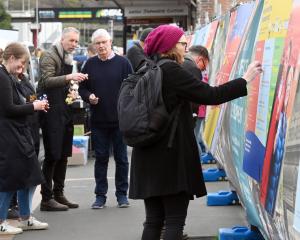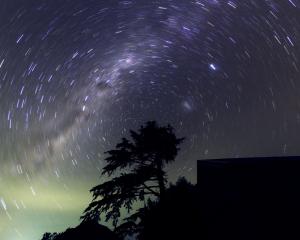A lagoon that once prompted dismay is now once more recognised as a precious resource, Shirley McKewen writes.
When early European settlers landed on Waikouaiti Beach about 1838, they looked with dismay at the low-lying swampy land covered with flax and rushes. It was not the productive farmland they had expected to see.
The extensive wetland area well known to local Maori and used as an important food-gathering place, has, since that time, been reduced in size by 85% and now covers only 51ha. Originally known to Europeans as the ''Government swamp'', local Maori named the lagoon area Matainaka, which translated means ''child of the minnow'' (or ''whitebait'') an indication of the important role the wetland had as a spawning place.
Tuna (eels), flounder and varieties of native waterfowl were plentiful, providing food for local whanau. A fishing easement granted in 1868 was in response to an agreement with Kai Tahu to preserve mahika kai sites at the time of Kemp's purchase in 1848. However, a protracted land squabble between Johnny Jones and the government of the day resulted in the alienation of Maori from their use of the area.
In the 1860s the wetlands in the district were substantially drained to provide settlers with farmland, especially important as the whaling industry was in decline and the Central Otago gold-rush years were all but over. Work was to begin in the upper lagoon (now the Waikouaiti Racecourse) at an estimated cost of 250. The Otago Witness in September 1881 reported plans for dividing the lower lagoon with causeways as a precursor to draining all this area too.
The work continued until 1901 and during this time three major linking causeways were built on what is now known as Hawksbury Lagoon. Today one of the causeways is in a state of disrepair, but it clearly shows the original construction technique used. Upright totara posts were spaced at 1m intervals and backfilled with rocks and clay soil.
This crumbling causeway is today used by waterfowl as a nesting site because it is largely isolated from disturbance and predators. The present-day lagoon was actually drained in 1883 but a public petition required that it be refilled the following year. Today, 2km of causeways remain for use as a walking/biking track and for bird-spotting.
A wide range of wildlife has always frequented the lagoon, helped by officialdom from time to time, starting in 1866 when black swans imported from Australia and released in Oamaru found Hawksbury Lagoon more to their liking and relocated. In January 1887 and again in 1889 500 brown trout were liberated and in 1897, as part of a national project, a number of mallard ducks were released. Fish numbers rapidly declined but the ducks managed much better. There was great excitement when the April 1902 edition of the Otago Witness reported the first white heron to be seen on the lagoon.
Today few fish of any sort make the lagoon their home, apart from a few eels and common bullies, but the range of birds has increased as they use the lagoon as a stopover on their migratory journey up and down the country at intervals. At different times of the year shoveler ducks, grey teal, pied stilts, spoonbills, black-billed gulls, herons, shags, black swans and geese are commonly seen. In the order of 3500 birds have been counted at the lagoon at a time.
Between 1886 and 1912 the Hawksbury Domain area (which included the lagoon) was managed by the domain board, and then in 1899 was gazetted as a reserve for native and imported game birds, becoming a sanctuary for native and imported game in 1929. In 1953 it was redesignated as a wildlife refuge before coming under the auspices of the Wildlife Service in 1974. Today it is the responsibility of the Department of Conservation and included within the East Otago Taiapure which was established in 1999.
In 1984 a public meeting was held and the Waikouaiti and Karitane Beautifying Society was established. This group included Hawksbury Lagoon in their work until eventually in 1991 a subcommittee was created to focus solely on the lagoon. Over the next 10 years this group of residents repaired the causeways and culverts, planted trees and shrubs as well as going through the lengthy process of obtaining permission prior to assembling and erecting the ''green bridge'' over Post Office Creek.
The bridge was intended as a precursor to building a wheelchair-accessible boardwalk around the perimeter of the northern arm and completing the circuit with another bridge to be constructed over Post Office Creek on to the Maori Reserve land. This plan has not been implemented but might still be included in the future.
Matainaka was also the subject of an ancillary claim in 1995 to the Waitangi Tribunal in recognition of the importance of Hawksbury Lagoon to early Maori. Unfortunately much of the Maori Reserve land is difficult to access and the potential construction of a bridge would improve the present situation. One of the causeways bisects the area and it is only thanks to the generosity of the local runaka, that people are permitted to use the area.
Much of the present-day volunteer work at the lagoon is directed by an ecological management plan commissioned by the local interest group in 2011. This has helped identify areas for planting as well as the type of plants most suited to each area. Since this plan was completed, thousands of plants have been planted on an old tip site, along lagoon margins and the edges of the causeways. Work has also been carried out to reopen the walkway along the northern arm where totara had been planted to mark the beginning of the new millennium.
A planting of aquatic rushes and grasses mostly did not survive and a short-term study to investigate the metal concentrations of the sediment was undertaken by a student from the University of Otago, but no definite conclusions were reached. The demise of the aquatic plants may have been due to salinity or increased water levels.
Over the years it has always been the quantity and quality of the water that has provoked much discussion within the community. In summer, the lagoon can become quite smelly when the sediment is exposed. On average the lagoon is only half a metre deep, so it can and does dry out fairly quickly. In winter, high-rainfall events which coincide with high tides can cause consternation to owners of low-lying properties as the outlet to Waikouaiti Beach is only intermittently open and it becomes a matter of waiting for the tidal outlet to be lower than the main lagoon before the culvert gates can be opened and the main body of water allowed to escape.
The lagoon is in a eutrophic state, common to many similarly situated lagoons around the world. In this case it is primarily due to the construction of the causeways limiting access to the flushing effects of the sea, and to the change from nativebush-covered surrounding hills to pastoral grazing land. A water management report commissioned last year outlines potential options for improving the poor state of health of the lagoon. For a remedy to be determined, consultation needs to occur, which will involve local residents, the Department of Conservation, the Maori reserves trustees, Dunedin City Council, the East Otago Taiapure and the Otago Regional Council before an agreement can be reached.
Whatever is decided, we know that it is going to take years before there is any noticeable improvement. Our present task is to at least halt the decline and make the small changes necessary to begin the process of restoration to a healthier trophic state. To this end, volunteers continue to plant native species around the lagoon, encourage landowners in the wider catchment to fence their waterways to stop stock access, and seek to reduce pollutants from entering in the lagoon.
Attitudes are changing as we are all becoming more aware of the importance of these scarce types of estuarine wetland areas and the value of cleaner water, not just for us but for wildlife. The community is taking a greater interest in this wetland situated in the middle of their town, and has a better understanding of the need to protect and preserve such scarce ecosystems. This bodes well for the future development and health of Hawksbury Lagoon.
- Shirley McKewen is chairwoman of the Hawksbury Lagoon Committee.
Public meeting
The Hawksbury Lagoon Committee is holding a public meeting on Monday, February 10, at 6.30pm, at the East Otago Events Centre, for the community to discuss management options for the Hawksbury Lagoon as identified in the Water Management Report. The Water Management Report is available from www.hawksburylagoon.org.nz or at the Waikouaiti Library.












